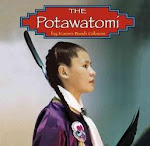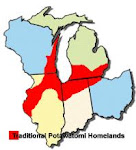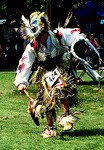John Crampton, a member of the little River Band of Ottawa Indians, still remembers the days when he attended the Mount Pleasant Indian School at age 6. Eighty-three years later, as he walked the grounds of the former school, he reminisced about his childhood.
"That was the big boys dormitory," Crampton said, "over there was a deer pen. The buildings for the teachers and staff was over there."
The Mount Pleasant Indian Industrial School operated in Michigan from 1893-1933. The school, at peak enrollment, had about 150 girls and 175 boys from the Chippewa, Ottawa and Potawatomi tribes, according to documents at the Mount Pleasant Center.
An excert from October 1, 1889 report from the Commissioner of Indian Affairs shows what the U.S. government's mind-set was like at the time: "The Indians must conform to the white man's way, peaceably if they will, forcibly if they must," the report stated.
The removal of Native American children from their families and communities was the U.S. government's intentional plan to assimilate the Indians into white Euro-American society during the period between 1880 and the 1920s, according to Alice Littlefields research on the Bureau of Indian Affairs' Boarding Schools, "Theories of Resistance and social Reproductions."
Crampton pointed to the boarded-up brick buildings still standing on what is now the Mount Pleasant Center. "The sidewalk is still here," he said. "I imagine these trees were here when I was here".
"The girls were on the other side from the boys. We had an ice house, a stable, a gym, and I learned how to swim in the creek just north of here," he said.
Crampton has fond memories of friends, regular meals and clean clothes. "If it wasn't for this school, I would have starved to death. I liked the uniforms. They were warm," he said. Crampton said he learned how to cut hair at the school and attended church.
Thousands of American Indian children from Michigan and other states attended the federally run school. Saginaw Chippewa Tribe mamber Carole Tally said both her parents were sent to the school. "It was a very depressing time for the family," she said. "They just came in and took kids."
In the community of her mother, Nellie Ashmum, people were scared when they saw white people coming around because they thought they would be taken away. "My dad, he had to be sent away" as a young child, Tally said. "He had negative feelings about jis (boarding school) experience. He used to be a basket maker, and they wouldn't let him do it anymore."
In 1991, Crampton and about 12 other elders, who attended the Mount Pleasant school, discussed their experiences at a reunion organized by Paul Johnson of the Michigan Education Association. Johnson facilitated a recorded discussion with the elders from Ojibwa, Chippewa, Ottawa and Potawatomi communities about their experiences living at the school.
According to official documents at Ziibiwing, "The establishment of the school in 1893 and its closing in 1933 were the result of shifts in federal Indian policy changes in education, philosophy and changes in the U.S. economy."
About 50 boys and girls enrolled in the school when it closed were labeled orphaned and housed in dormitories and sent to public schools, according to the Isabella County newspaper. The state designated the original Indian Industrial school Chapel and Indian Cemetery as historical landmarks in 1987.
The Indian boarding school era historically has been blamed for the decimation of the Native American culture and their disconnection with tradition, heritage, and most especially , the language of Native American people.
In 1926, they made Indians citizens but it didn't make a lot of difference to Indians back then because they were still Indians. My grandmother was sent to this school and the reason I tell you this story is so everyone will understand partially how Native Americans got to the point were Indian Health Services would be granted along with a whole slew of other rights that would be granted to the Native American. An effort by the U.S. government to restore and save the endangered Native American, and why not we save endangered animals.
Source: The Grand Rapids Press
YouTube true story link
NPR Indian boarding school podcast link
,+Karen+Bush+Gibson,+Ex-+-+eBay+(item+360233250981+end+time+Mar-09-10+19-22-27+PST)_1265816805474.jpeg)






































No comments:
Post a Comment